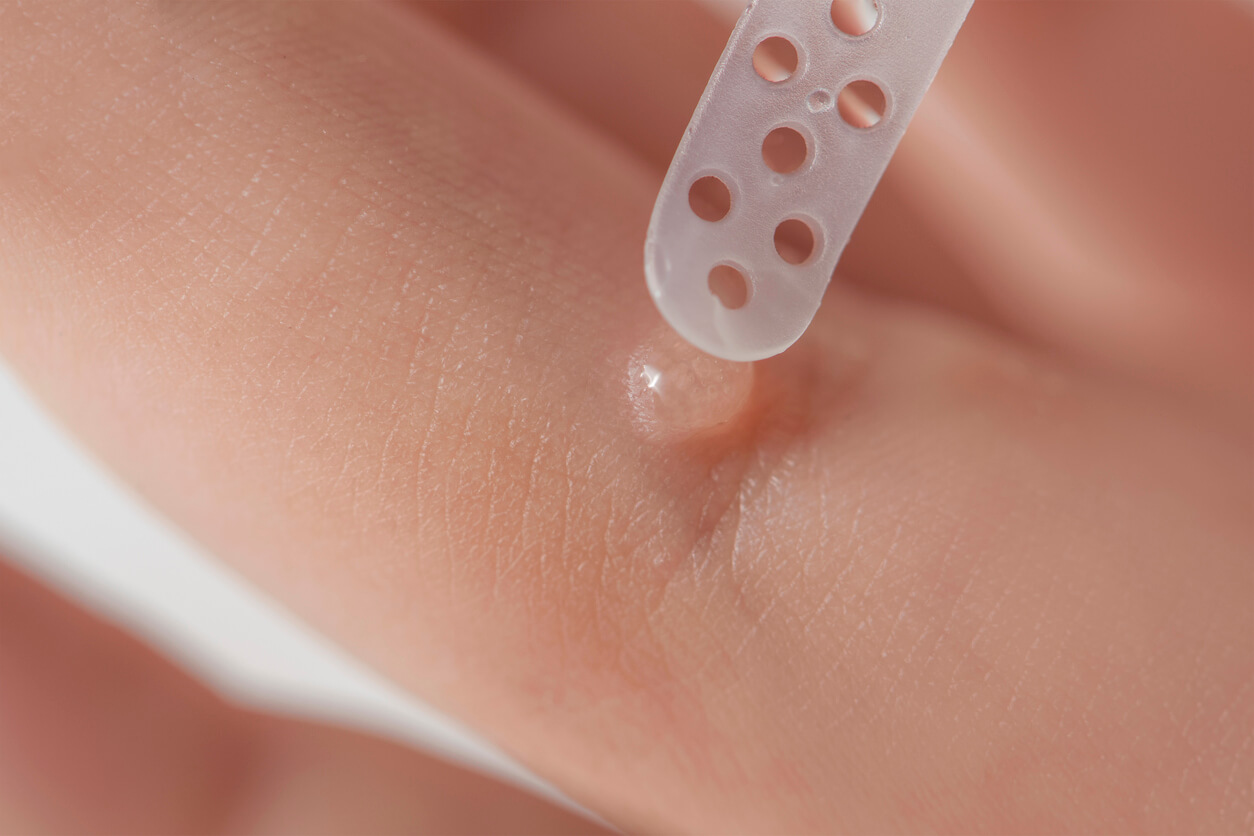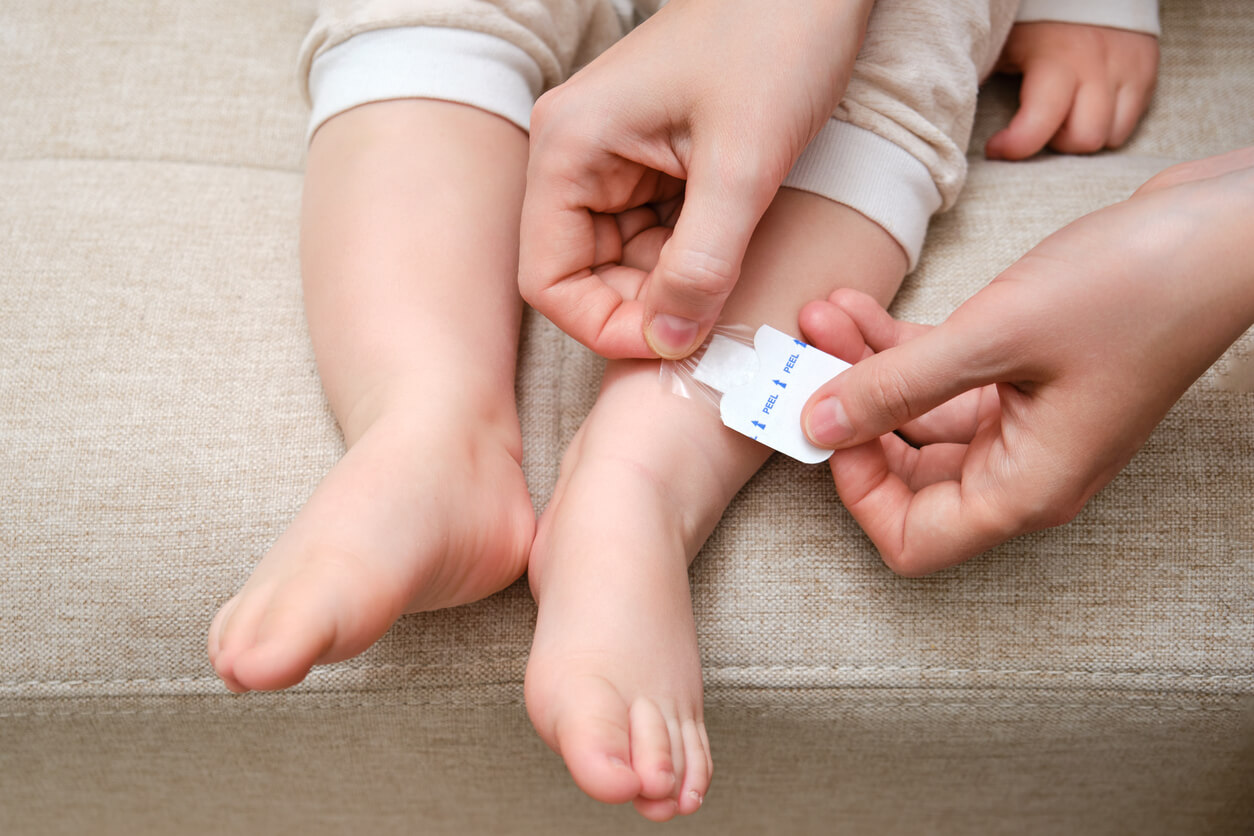Warts in Babies: Causes and Treatment


Written and verified by the dermatologist Maria del Carmen Hernandez
Warts are benign lesions that occur on the skin and mucous membranes. They’re transmitted by direct or indirect contact and affect about 10% of the population. They can appear at any age, although warts in babies are rare. In general, they become more frequent at school age, where the prevalence is between 10 and 20%.
Similarly, most warts are harmless and disappear in a matter of years, and it’s rare for them to become malignant. If your child has one of these lesions and you’re concerned, find out all you need to know.
Why do warts in babies occur?
Although warts in babies are rare, they increase as children grow older and come into contact with other children. Warts are caused by HPV (human papillomavirus), of which more than 100 different types have been identified, and can develop in any location on the body.
In addition, viral warts are transmitted by direct skin-to-skin contact. However, they can also be spread by touching objects such as towels or washcloths. In this regard, soft, moist, or injured skin is more likely to be infected.
Viruses have the ability to multiply on the skin. Therefore, if someone has a weakened immune system, the body can’t always fight back successfully.
Read also: Angel Kisses and Stork Bites: Spots on Baby’s Skin

Types of warts
Primary manifestations of HPV include genital, common, flat, palmar, and deep plantar warts. Some of the high-risk HPV subtypes are associated with neoplasms, including types 6, 11, 16, 16, 18, 31, and 35. In fact, malignant transformation is often seen in genital warts and in immunocompromised patients.
- Vulgar warts: The most common are associated with types 2 and 4, and then with types 1, 3, 27, 29, and 57. They can appear on any area of the body, but most frequently around the nails or where there’s a skin lesion.
- Flat: These are types 3, 10, and 28. They’re usually small and flat, pink in color, or the same color as the surrounding skin.
- Deep palmoplantar warts: They’re caused by type 1 and also 2, 3, 4, 27, and 57. When located on the sole of the foot, they can cause pain even when resting and simulate corns. They tend to appear grouped on the face without associated symptoms.
- Filiform: These are small, long, and narrow growths. In most cases, they occur in the area around the mouth, on the neck, or on the face.
Warts located on the sole of the foot can be painful due to extensive friction and compression. If they’re large, they can even make it difficult to walk and make it difficult to wear shoes.
Treatment options for warts in babies
Although treatment can be complicated, warts usually resolve spontaneously within a few years. The procedure depends on the symptoms, patient or family preferences, and cost. However, although there are many therapeutic options for warts, none are very effective and recurrences are quite common with each of them. In addition, none of these options can be put into practice when it comes to warts in babies.
For over-the-counter lotions to be effective, it’s important to get first rid of the hard skin on the surface of the wart. Therefore, after each bath, you can gently rub the surface of the wart with a file to make it smooth. Then, it’s a good time to use an effective over-the-counter treatment.
You may be interested in: How to Avoid Skin Irritation in Babies?

What steps can you take to prevent warts in babies?
If someone in the household has warts, clean floor surfaces and bathtubs. Ideally, a diluted bleach solution should be used before placing the baby in these areas. Another recommended option is to use a different washcloth and towel for each family member. In addition, frequent hand washing is essential.
Similarly, there’s no way to completely prevent the development of warts in infants, although certain measures can be taken to try to do so. In this regard, some of the recommendations of the American Academy of Dermatology Association are not to rub, scratch, or pinch warts. Even children’s toys should be kept clean.
Warts in babies are harmless
Warts are harmless growths caused by the human papillomavirus. Although they’re more common in children than in adults, they can develop at any age. There are several types of warts with different appearances that usually disappear without treatment within several weeks.
Warts are benign lesions that occur on the skin and mucous membranes. They’re transmitted by direct or indirect contact and affect about 10% of the population. They can appear at any age, although warts in babies are rare. In general, they become more frequent at school age, where the prevalence is between 10 and 20%.
Similarly, most warts are harmless and disappear in a matter of years, and it’s rare for them to become malignant. If your child has one of these lesions and you’re concerned, find out all you need to know.
Why do warts in babies occur?
Although warts in babies are rare, they increase as children grow older and come into contact with other children. Warts are caused by HPV (human papillomavirus), of which more than 100 different types have been identified, and can develop in any location on the body.
In addition, viral warts are transmitted by direct skin-to-skin contact. However, they can also be spread by touching objects such as towels or washcloths. In this regard, soft, moist, or injured skin is more likely to be infected.
Viruses have the ability to multiply on the skin. Therefore, if someone has a weakened immune system, the body can’t always fight back successfully.
Read also: Angel Kisses and Stork Bites: Spots on Baby’s Skin

Types of warts
Primary manifestations of HPV include genital, common, flat, palmar, and deep plantar warts. Some of the high-risk HPV subtypes are associated with neoplasms, including types 6, 11, 16, 16, 18, 31, and 35. In fact, malignant transformation is often seen in genital warts and in immunocompromised patients.
- Vulgar warts: The most common are associated with types 2 and 4, and then with types 1, 3, 27, 29, and 57. They can appear on any area of the body, but most frequently around the nails or where there’s a skin lesion.
- Flat: These are types 3, 10, and 28. They’re usually small and flat, pink in color, or the same color as the surrounding skin.
- Deep palmoplantar warts: They’re caused by type 1 and also 2, 3, 4, 27, and 57. When located on the sole of the foot, they can cause pain even when resting and simulate corns. They tend to appear grouped on the face without associated symptoms.
- Filiform: These are small, long, and narrow growths. In most cases, they occur in the area around the mouth, on the neck, or on the face.
Warts located on the sole of the foot can be painful due to extensive friction and compression. If they’re large, they can even make it difficult to walk and make it difficult to wear shoes.
Treatment options for warts in babies
Although treatment can be complicated, warts usually resolve spontaneously within a few years. The procedure depends on the symptoms, patient or family preferences, and cost. However, although there are many therapeutic options for warts, none are very effective and recurrences are quite common with each of them. In addition, none of these options can be put into practice when it comes to warts in babies.
For over-the-counter lotions to be effective, it’s important to get first rid of the hard skin on the surface of the wart. Therefore, after each bath, you can gently rub the surface of the wart with a file to make it smooth. Then, it’s a good time to use an effective over-the-counter treatment.
You may be interested in: How to Avoid Skin Irritation in Babies?

What steps can you take to prevent warts in babies?
If someone in the household has warts, clean floor surfaces and bathtubs. Ideally, a diluted bleach solution should be used before placing the baby in these areas. Another recommended option is to use a different washcloth and towel for each family member. In addition, frequent hand washing is essential.
Similarly, there’s no way to completely prevent the development of warts in infants, although certain measures can be taken to try to do so. In this regard, some of the recommendations of the American Academy of Dermatology Association are not to rub, scratch, or pinch warts. Even children’s toys should be kept clean.
Warts in babies are harmless
Warts are harmless growths caused by the human papillomavirus. Although they’re more common in children than in adults, they can develop at any age. There are several types of warts with different appearances that usually disappear without treatment within several weeks.
All cited sources were thoroughly reviewed by our team to ensure their quality, reliability, currency, and validity. The bibliography of this article was considered reliable and of academic or scientific accuracy.
- Al Aboud, A. M., & Nigam, P. K. (2022). Wart. In StatPearls. StatPearls Publishing.
- American Academy of Dermatology. Warts: Tips for managing. Available from: https://www.aad.org/public/diseases/a-z/warts-self-care
- Lipke, M. M. (2006). An armamentarium of wart treatments. Clinical medicine & research, 4(4), 273–293. https://doi.org/10.3121/cmr.4.4.273
- Gerlero, P., & Hernández-Martín, Á. (2016). Treatment of Warts in Children: An Update. Actualización sobre el tratamiento de las verrugas vulgares en los niños. Actas dermo-sifiliograficas, 107(7), 551–558. https://doi.org/10.1016/j.ad.2016.04.010
- Silverberg, N. B. (2019). Pediatric warts: update on interventions. Cutis, 103(1), 26–E4.
This text is provided for informational purposes only and does not replace consultation with a professional. If in doubt, consult your specialist.








